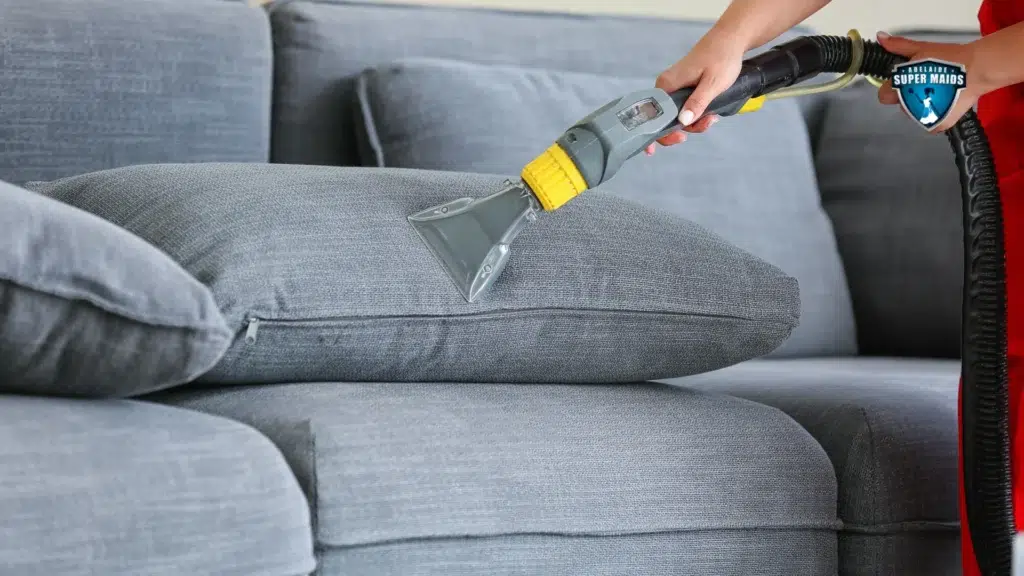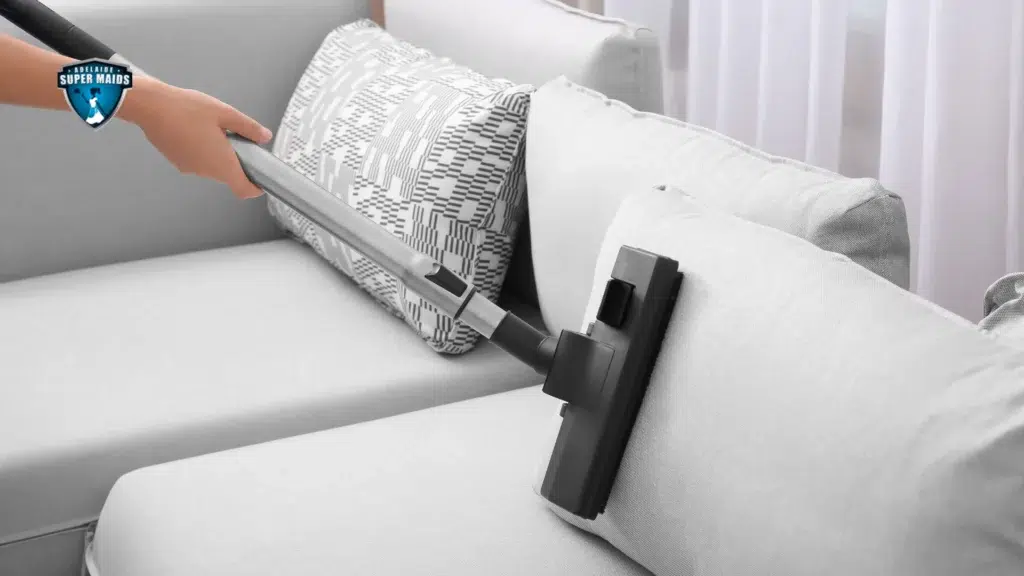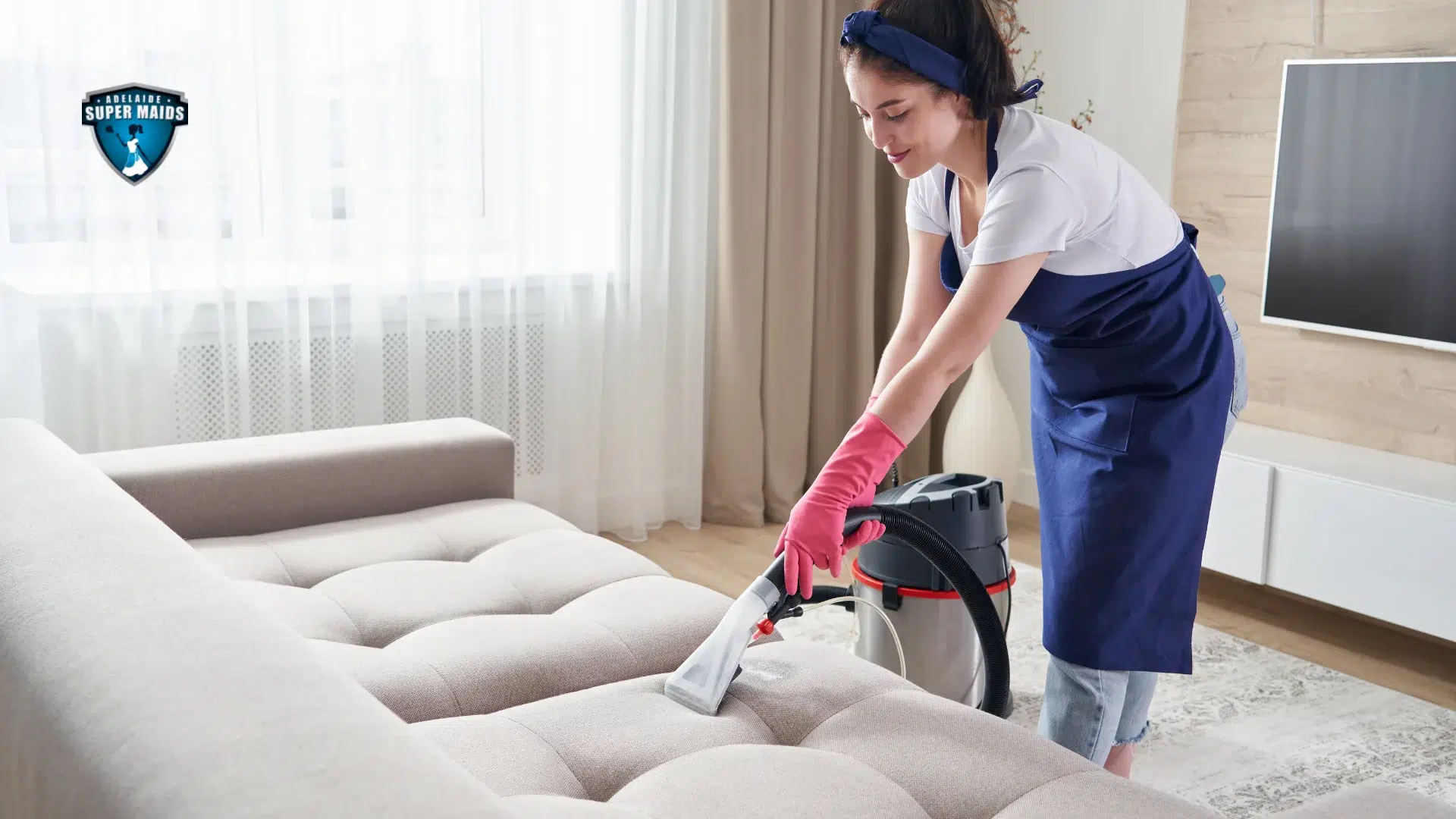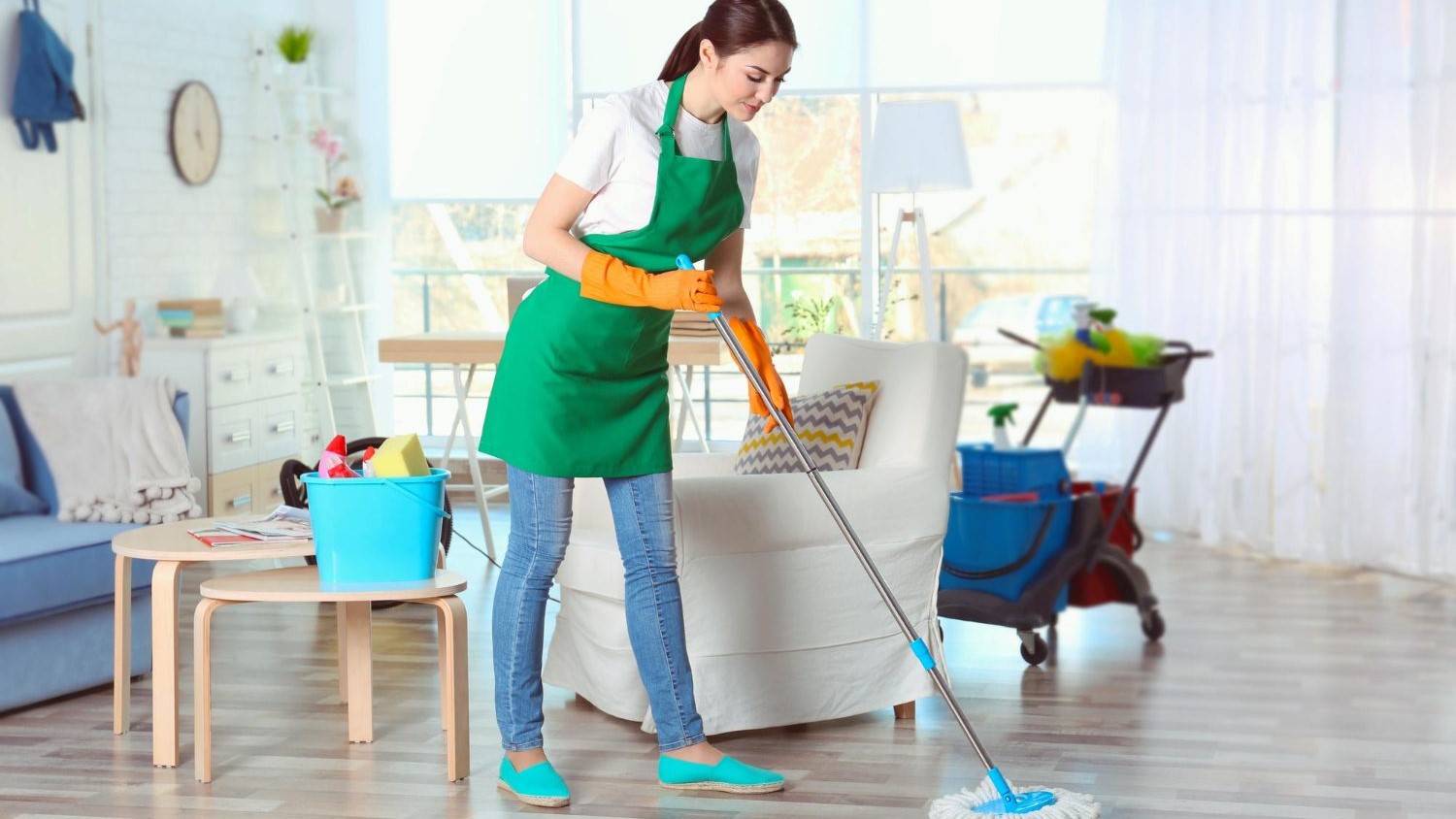Keeping your fabric couch clean isn’t just about appearances—it’s about maintaining a healthy and inviting home. A spotless couch can make your living space feel fresh and cosy, making it a perfect spot to relax after a long day.
But let’s face it, fabric couches can be tricky to clean. Stains, spills, and everyday dirt can quickly turn your beautiful couch into a bit of an eyesore.
Fear not! We’re here to share some simple tips on how to clean fabric couch like a pro.
Whether you’re dealing with a pesky wine stain or just want to give your couch a routine refresh, these tips will help you keep your upholstery looking its best. So, roll up your sleeves and let’s dive into the world of fabric couch cleaning.
You’ll soon see that with the right approach, it’s easier than you think!
Table of Contents
Know Your Fabric
Before you start scrubbing away, it’s crucial to know what kind of fabric you’re dealing with. Different materials require different cleaning methods, and using the wrong one could damage your couch.
Common Fabric Types:
- Cotton and Linen: These natural fibres are breathable and comfortable but can be prone to staining and wrinkling.
- Microfiber: Known for its durability and stain resistance, microfiber is a popular choice for households with kids and pets.
- Velvet: Luxurious and soft, velvet requires gentle care to maintain its plush texture.
- Polyester and Nylon: These synthetic fabrics are often used in blends for their strength and resistance to wrinkles and fading.
Check the Manufacturer’s Tag: Look for the cleaning code on the manufacturer’s tag, usually found under the cushions or on the back of the couch. This tag will guide you on the safest cleaning methods:
- W: Water-based cleaning solutions are safe to use.
- S: Only use solvent-based cleaners.
- WS: Both water-based and solvent-based cleaners are safe.
- X: Professional cleaning is recommended; avoid DIY methods.
Knowing your fabric type and its specific cleaning requirements is the first step to ensuring your cleaning efforts are both safe and effective.
Now, let’s gather the supplies you’ll need to tackle any mess your fabric couch might encounter.

Gather Your Cleaning Supplies
Before diving into the cleaning process, it’s essential to have the right tools at hand. Having the right supplies will make the task easier and ensure you’re prepared for any stains or dirt that come your way.
Essential Cleaning Supplies:
- Vacuum Cleaner: A vacuum with an upholstery attachment is perfect for removing dust, crumbs, and pet hair from your fabric couch.
- Soft Brush: A soft-bristled brush can help lift surface dirt and refresh the fabric’s texture.
- Mild Detergent: A gentle detergent or a specialized upholstery cleaner will be effective for most fabric types. Ensure it’s safe for your specific couch fabric by checking the label.
- White Cloths or Sponges: Use these to apply cleaning solutions and blot stains. White cloths are best as they won’t transfer dyes to your fabric.
- Spray Bottle: A spray bottle is useful for applying water-based cleaning solutions evenly.
- Distilled Water: Using distilled water helps avoid any mineral deposits or water stains on your couch.
- Rubbing Alcohol: For couches that can be cleaned with solvents, rubbing alcohol is a handy and effective option.
Optional Tools for Tough Stains:
- Baking Soda: Great for deodorizing and tackling tough stains. Sprinkle it on your couch and vacuum it up after a few hours.
- Vinegar: Mixed with water, vinegar can be a powerful cleaner for water-safe fabrics.
- Steam Cleaner: If your couch’s fabric tag indicates it’s safe to use water-based cleaners, a steam cleaner can provide a deep clean.
With your supplies ready, you’re all set to tackle the cleaning process.
Gather Your Cleaning Supplies
Before diving into the cleaning process, it’s essential to have the right tools at hand. Having the right supplies will make the task easier and ensure you’re prepared for any stains or dirt that come your way.
Essential Cleaning Supplies:
- Vacuum Cleaner: A vacuum with an upholstery attachment is perfect for removing dust, crumbs, and pet hair from your fabric couch.
- Soft Brush: A soft-bristled brush can help lift surface dirt and refresh the fabric’s texture.
- Mild Detergent: A gentle detergent or a specialized upholstery cleaner will be effective for most fabric types. Ensure it’s safe for your specific couch fabric by checking the label.
- White Cloths or Sponges: Use these to apply cleaning solutions and blot stains. White cloths are best as they won’t transfer dyes to your fabric.
- Spray Bottle: A spray bottle is useful for applying water-based cleaning solutions evenly.
- Distilled Water: Using distilled water helps avoid any mineral deposits or water stains on your couch.
- Rubbing Alcohol: For couches that can be cleaned with solvents, rubbing alcohol is a handy and effective option.
Optional Tools for Tough Stains:
- Baking Soda: Great for deodorizing and tackling tough stains. Sprinkle it on your couch and vacuum it up after a few hours.
- Vinegar: Mixed with water, vinegar can be a powerful cleaner for water-safe fabrics.
- Steam Cleaner: If your couch’s fabric tag indicates it’s safe to use water-based cleaners, a steam cleaner can provide a deep clean.
With your supplies ready, you’re all set to tackle the cleaning process.
Professional Upholstery Cleaner In Adelaide
Pre-Cleaning Preparations
Before you start cleaning your fabric couch, taking a few preparatory steps can save you time and prevent potential damage. Proper preparation ensures you’re ready to tackle any dirt or stains effectively.
Check the Manufacturer’s Cleaning Instructions: First, always refer to the manufacturer’s cleaning instructions, usually found on a tag under the cushions or on the back of the couch.
These instructions are tailored to your specific couch fabric and will provide the safest and most effective cleaning methods.
Spot Test in a Hidden Area: Before applying any cleaning solution to a visible part of your couch, it’s wise to do a spot test.
Choose a small, hidden area and apply a small amount of the cleaner. Wait a few minutes to see if there’s any adverse reaction, such as discolouration or fabric damage.
If everything looks good, you can proceed with more confidence.
Remove Loose Debris: Start by removing any loose debris from the couch.
Use your vacuum cleaner with an upholstery attachment to thoroughly vacuum the entire surface of the couch, including under the cushions and in crevices.
This will remove dust, crumbs, and pet hair, making the cleaning process more effective.
Gather Cushions and Removable Covers: If your couch has removable cushions or covers, take them off and prepare to clean them separately.
Follow the manufacturer’s instructions for washing these items. If they’re machine washable, use a gentle cycle and air dry them to avoid shrinkage or damage.
Protect Surrounding Areas: To prevent any cleaning solutions or water from damaging your flooring or other furniture, place a drop cloth or old towels around the base of your couch.
This will catch any drips or spills during the cleaning process.
Regular Maintenance
Maintaining your fabric couch regularly is key to keeping it looking its best and extending its lifespan. Simple routine care can prevent dirt and stains from becoming a bigger problem down the line.
Vacuuming: Regular vacuuming is the foundation of fabric couch maintenance.
Use your vacuum cleaner’s upholstery attachment to gently vacuum the entire surface of the couch at least once a week. Pay special attention to high-traffic areas, such as the seats and armrests, as well as crevices where crumbs and dirt can accumulate.
Brushing: A soft brush can help lift and remove surface dirt and keep the fabric looking fresh.
Gently brush the couch in a circular motion to dislodge dirt and refresh the fabric’s texture. This is especially useful for fabrics like velvet, which can benefit from regular brushing to maintain their plush appearance.
Fluffing Cushions: Fluffing your couch cushions regularly helps them maintain their shape and comfort.
Remove the cushions and give them a good shake, then knead them with your hands to redistribute the filling evenly. This simple step can make your couch look plumper and more inviting.
Rotate Cushions: If your couch has removable cushions, rotate them regularly to ensure even wear.
This helps prevent certain areas from becoming overly worn or flattened. Simply swap the cushions around or flip them over to distribute the usage more evenly.
Spot Clean Spills Immediately: Accidents happen, but addressing spills right away can prevent stains from setting in.
Blot spills with a clean, white cloth or paper towel to absorb as much liquid as possible. Avoid rubbing, as this can push the stain deeper into the fabric.
Once you’ve blotted up the spill, follow up with a spot cleaner suitable for your fabric type.
Use Fabric Protector: Consider applying a fabric protector to your couch.
These products create a protective barrier on the fabric, making it easier to clean up spills before they turn into stains. Be sure to follow the manufacturer’s instructions when applying the fabric protector.

How To Treating Stains
No matter how careful you are, stains on a fabric couch are inevitable. Knowing how to treat them quickly and effectively can make a huge difference in maintaining your couch’s appearance.
Here are some tips for handling both general and specific stains.
General Stain Removal:
- Blot, Don’t Rub: As soon as a spill occurs, use a clean, white cloth to blot the area. Rubbing can push the stain deeper into the fabric fibres.
- Use Mild Detergent: Mix a small amount of mild detergent with water. Dampen a cloth with the solution and gently blot the stain. Avoid soaking the fabric.
- Rinse and Blot Dry: Use a clean cloth dampened with plain water to rinse out the detergent solution. Blot the area dry with a dry cloth to remove excess moisture.
Specific Stains:
Wine Stains:
- Blot up as much wine as possible with a clean cloth.
- Mix a solution of equal parts water and white vinegar.
- Dampen a cloth with the solution and blot the stain gently.
- Rinse with water and blot dry.
Coffee Stains:
- Blot the coffee with a clean cloth.
- Mix a solution of mild detergent and water.
- Blot the stain with the solution, then rinse and blot dry.
Pet Stains:
- Blot up any liquid with a clean cloth.
- Use an enzyme cleaner specifically designed for pet stains.
- Follow the manufacturer’s instructions for applying and removing the cleaner.
Grease Stains:
- Sprinkle baking soda or cornstarch on the stain to absorb the grease.
- Let it sit for 15-20 minutes, then vacuum it up.
- Dab the area with a cloth dampened with rubbing alcohol.
Ink Stains:
- Dab rubbing alcohol onto a cotton ball or cloth.
- Blot the ink stain gently, being careful not to spread it.
- Rinse with water and blot dry.
Preventative Measures for Stains:
- Immediate Action: The faster you act on a stain, the easier it will be to remove.
- Keep Cleaning Supplies Handy: Have a stash of basic cleaning supplies readily available for quick response to spills.
- Regular Maintenance: Regular vacuuming and spot cleaning can prevent dirt from building up and becoming harder to remove.
Deep Cleaning Techniques
Every so often, your fabric couch will benefit from deep cleaning to remove embedded dirt and refresh the fabric. Here are some effective deep-cleaning techniques you can use, depending on the type of fabric and the manufacturer’s recommendations.
Water-Based Cleaning:
- Mix a Cleaning Solution: Combine a small amount of mild detergent with warm water in a spray bottle. Shake gently to mix.
- Test in a Hidden Area: Always test the solution on a small, inconspicuous area of the couch first to ensure it doesn’t cause discolouration or damage.
- Spray and Blot: Lightly spray the cleaning solution onto the fabric, taking care not to oversaturate it. Blot the area with a clean, white cloth to lift dirt and grime.
- Rinse and Blot Dry: Use a cloth dampened with plain water to remove any soap residue. Blot the area dry with a clean towel.
Solvent-Based Cleaning:
- Choose the Right Solvent: Select a solvent-based cleaner that is safe for your fabric type. Look for products specifically designed for upholstery cleaning.
- Apply the Solvent: Dampen a clean cloth with the solvent and gently blot the stained areas. Avoid pouring the solvent directly onto the fabric.
- Blot and Dry: Continue blotting until the stain lifts. Use a clean, dry cloth to remove excess solvent and allow the fabric to air dry completely.
Steam Cleaning:
- Check Fabric Compatibility: Ensure your couch fabric can safely be steam cleaned. Check the manufacturer’s tag for a “WS” or “W” cleaning code.
- Prepare the Steam Cleaner: Fill the steam cleaner with water according to the manufacturer’s instructions. Allow it to heat up.
- Steam Clean the Couch: Working in sections, move the steam cleaner over the fabric in a slow, steady motion. Avoid lingering too long in one spot to prevent oversaturation.
- Dry Thoroughly: Allow the couch to dry completely before using it again. Open windows or use fans to speed up the drying process.
Homemade Deep Cleaner:
- Mix Ingredients: Combine 1 cup of distilled water, 1/4 cup of white vinegar, and 1 tablespoon of mild dish soap in a spray bottle.
- Apply and Scrub: Lightly spray the solution onto the fabric and use a soft brush to scrub gently in circular motions.
- Rinse and Dry: Rinse with a cloth dampened with plain water and blot dry with a clean towel.
Deep cleaning your fabric couch periodically will keep it looking fresh and free of deep-seated dirt. After deep cleaning, it’s essential to dry the couch properly to prevent any damage.
When to Call a Professional
Despite your best efforts, there are times when professional cleaning is necessary to restore your fabric couch to its former glory. Knowing when to call in the experts can save you time and ensure your couch gets the care it needs.
Persistent Stains:
- Stubborn Marks: If you have stains that don’t respond to DIY treatments, it’s time to seek professional help. Professionals have access to specialized equipment and cleaning solutions that can effectively remove even the most stubborn stains.
- Unknown Stains: For stains of unknown origin, professional cleaners can identify and use the correct methods to treat them without damaging the fabric.
Odor Removal:
- Lingering Smells: If your couch has persistent odours that don’t go away with regular cleaning, a professional deep clean can help. They use advanced techniques to eliminate odours at their source.
- Pet Odors: Pet urine and other strong smells often require professional-grade enzymes and deodorizers to fully remove.
Deep Cleaning:
- Annual Maintenance: Even with regular upkeep, an annual professional deep cleaning can help maintain your couch’s appearance and hygiene.
- High Traffic: If your couch is in a high-traffic area and sees a lot of use, more frequent professional cleanings might be necessary to keep it looking its best.
Fabric Care:
- Delicate Fabrics: If your couch is made from delicate or rare fabrics, professional cleaners are equipped to handle them with the appropriate care and techniques.
- Antique Furniture: For antique or heirloom furniture, professional cleaning ensures that the fabric and structure are preserved while getting cleaned.
Health Concerns:
- Allergy Relief: Professional cleaning can remove deep-seated allergens like dust mites, pet dander, and pollen, providing relief for allergy sufferers.
- Mold and Mildew: If you suspect mould or mildew in your couch, it’s crucial to call a professional immediately. They can safely and effectively eliminate these health hazards.
Promoting Your Services:
- Expert Care: Mention that your upholstery cleaning services offer expert care for all types of fabric couches.
- Special Offers: Highlight any special offers or discounts for first-time customers to encourage them to try your service.
- Convenient Scheduling: Emphasize the convenience and ease of scheduling a professional cleaning with your company.
By recognizing these signs and acting promptly, you can ensure your fabric couch remains in excellent condition. For those times when a professional touch is needed, our expert upholstery cleaning services are here to help.
Conclusion
Maintaining a clean and fresh fabric couch doesn’t have to be a daunting task. By understanding your fabric type, gathering the right supplies, and following regular maintenance and cleaning tips, you can keep your couch looking like new.
For those tougher stains and deep cleaning needs, don’t hesitate to call in the professionals. Ready to give your fabric couch the care it deserves?
Contact us today for expert upholstery cleaning services and enjoy a spotless, inviting home!
Contact Adelaide Supermaids Today!
Ready to experience the benefits of a professional upholstery cleaned? Booking an affordable house cleaner service in Adelaide is just a call or click away.
Here’s how you can get started:
Phone: 0451 787 887
Email: info@adelaide-supermaids.com.au
Website: Adelaide Super Maids House Cleaner
Office Hours:
Mon – Fri: 8:00 AM – 9:00 PM
Sat – Sun: 10:00 AM – 9:00 PM






